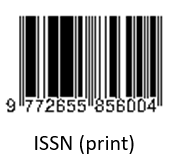Smart Technology in Construction Industry: Opportunity during COVID-19 Pandemic
(1) Universitas Indonesia
(2) Universitas Indonesia
(3) Universitas Indonesia
(*) Corresponding Author
Abstract
Full Text:
PDFReferences
World Health Organization, Novel Coronavirus(2019-nCoV) Situation Report – 22, (2020), [Online]. Available: https://www.who.int/docs/default-source/coronaviruse/situation-reports/20200211-sitrep-22 ncov.pdf?sfvrsn=fb6d49b1_2.
M. Usman, Y. Ali, A. Riaz, A. Riaz, and A. Zubair, Economic perspective of coronavirus (COVID-19), J. Public Aff., 20 (4) (2020) 1–5,
World Health Organization, WHO Health Emergency Dashboard - Indonesia Situation, (2022), https://covid19.who.int/region/searo/country/id (accessed Dec. 17, 2022).
A. Shibani, D. Hassan, and N. Shak, The Effects of Pandemic on Construction Industry in the UK, Mediterr. J. Soc. Sci., 2117 (2020) 48–60.
M. Raoufi and A. R. Fayek, Identifying Actions to Control and Mitigate the Effects of the COVID-19 Pandemic on Construction Organizations: Preliminary Findings, Public Work. Manag. Policy, 26 (1) (2021) 47–55,
Y. Yang et al., Opportunities and Challenges for Construction Health and Safety Technologies under the COVID-19 Pandemic in Chinese Construction Projects,” Int. J. Environ. Res. Public Heal. Artic., 18 (13038) (2021).
D. Y. Gamil and A. Alhagar, The Impact of Pandemic Crisis on the Survival of Construction Industry : A Case of COVID-19, Mediterr. J. Soc. Sci., 11 (4) (2020) 122–128.
A. Olanrewaju, A. AbdulAziz, C. N. Preece, and K. Shobowale, Evaluation of measures to prevent the spread of COVID-19 on the construction sites, Clean. Eng. Technol., 5 (100277) (2021).
D. Larasati, N. Ekawati, S. Triyadi, A. F. Muchlis, and A. Wardhani, Impact of the Pandemic COVID-19 on the Implementation of Construction Contracts, IOP Conf. Ser. Earth Environ. Sci., 738(1) (2021) 1–12,
R. Susanti, S. Fauziyah, and P. U. Pramesti, Lesson from pandemic Covid-19 for sustainability construction in Indonesia, AIP Conf. Proc., 2447 (1) (2021) 30013.
M. Xu, X. Nie, H. Li, J. C. P. Cheng, and Z. Mei, Smart construction sites: A promising approach to improving on-site HSE management performance, J. Build. Eng., 49 (2021).
M. Ion and G. Căruțașu, Smart Technology, Overview, and Regulatory Framework, Rom. Cyber Secur. J., 2 (1) (2020), [Online]. Available: https://rocys.ici.ro/spring-2020-no-1-vol-2/smart-technology-overview-and-regulatory-framework/.
M. Iqbal, N. Ahmad, M. Waqas, and M. Abrar, COVID-19 pandemic and construction industry: Impacts, emerging construction safety practices, and proposed crisis management framework, Brazilian J. Oper. Prod. Manag., 18 (2) (2021) 1–17.
Z. Li, Y. Jin, W. Li, Q. Meng, and X. Hu, Impacts of COVID-19 on construction project management: a life cycle perspective, Eng. Constr. Archit. Manag., (2022),
COVID-19 Handling Task Force, Peta Sebaran Perkembangan Kasus Covid-19 di Indonesia, (2022). https://covid19.go.id/en/peta-sebaran (accessed Mar. 22, 2022).
R. E. Caraka et al., Impact of COVID-19 large scale restriction on environment and economy in Indonesia, Glob. J. Environ. Sci. Manag., 6 (2020) 65–84.
Sugiyono, Metode Penelitian Kuantitatif, Kualitatif, dan R&D, 19th ed. Bandung: Alfabeta, (2013).
X. Chen, H. Yu, and F. Yu, What is the optimal number of response alternatives for rating scales? From an information processing perspective, J. Mark. Anal., 3 (2) (2015) 69–78.
J. Sarwono, Path Analysis dengan SPSS. Jakarta: Elex Media Komputindo, (2012).
V. Leontie, L. G. Maha, and I. C. Stoian, COVID-19 Pandemic and its Effects on the Usage of Information Technologies in the Construction Industry: The Case of Romania, Buildings, 12 (2) (2022).
S. Kim, M. Lee, I. Yu, and J. W. Son, Key Initiatives for Digital Transformation, Green New Deal and Recovery after COVID-19 within the Construction Industry in Korea, Sustain., 14 (14) (2022).
T. Ben-Zvi and J. Luftman, Post-Pandemic IT: Digital Transformation and Sustainability, Sustain., 14, (22) (2022) 1–11.
M. M. Kamal, The triple-edged sword of COVID-19: understanding the use of digital technologies and the impact of productive, disruptive, and destructive nature of the pandemic, Inf. Syst. Manag., 37 (4) (2020) 310–317.
J. P. Carvalho, L. Bragança, and R. Mateus, Optimising building sustainability assessment using BIM, Autom. Constr., 102 (2019) 170–182.
M. Zoghi and S. Kim, Dynamic modeling for life cycle cost analysis of BIM-based construction waste management, Sustain., 12 (12) (2020) 2483.
J. Čabala, M. Kozlovská, Z. Struková, and A. Tažíková, Benefits of BIM models and mixed reality in the implementation phase of construction projects, IOP Conf. Ser. Mater. Sci. Eng., 1252 (1) (2022) 012079.
S. Soltani, The Contributions of Building Information Modelling to Sustainable Construction, World J. Eng. Technol., 4 (2) (2016) 193–199.
A. Turkyilmaz, M. Guney, F. Karaca, Z. Bagdatkyzy, A. Sandybayeva, and G. Sirenova, A comprehensive construction and demolition waste management model using PESTEL and 3R for construction companies operating in central Asia, Sustain., 11 (6) (2019).
S. O. Abioye et al., Artificial intelligence in the construction industry : A review of present status , opportunities and future challenges, J. Build. Eng., 44 (2021).
H. Suparwito, Information Technology and Learning Methodology amid the COVID-19 Pandemic, Int. J. Appl. Sci. Smart Technol. 2 (2) (2020) 107–118.
A. A. Rafiq, E. Alimudin, and D. P. Rani, Employee Presence Using Body Temperature Detection and Face Recognition, Int. J. Appl. Sci. Smart Technol., 4 (2) (2022) 173–184.
DOI: https://doi.org/10.24071/ijasst.v5i1.5583
Refbacks
- There are currently no refbacks.
Publisher : Faculty of Science and Technology
Society/Institution : Sanata Dharma University

This work is licensed under a Creative Commons Attribution 4.0 International License.











